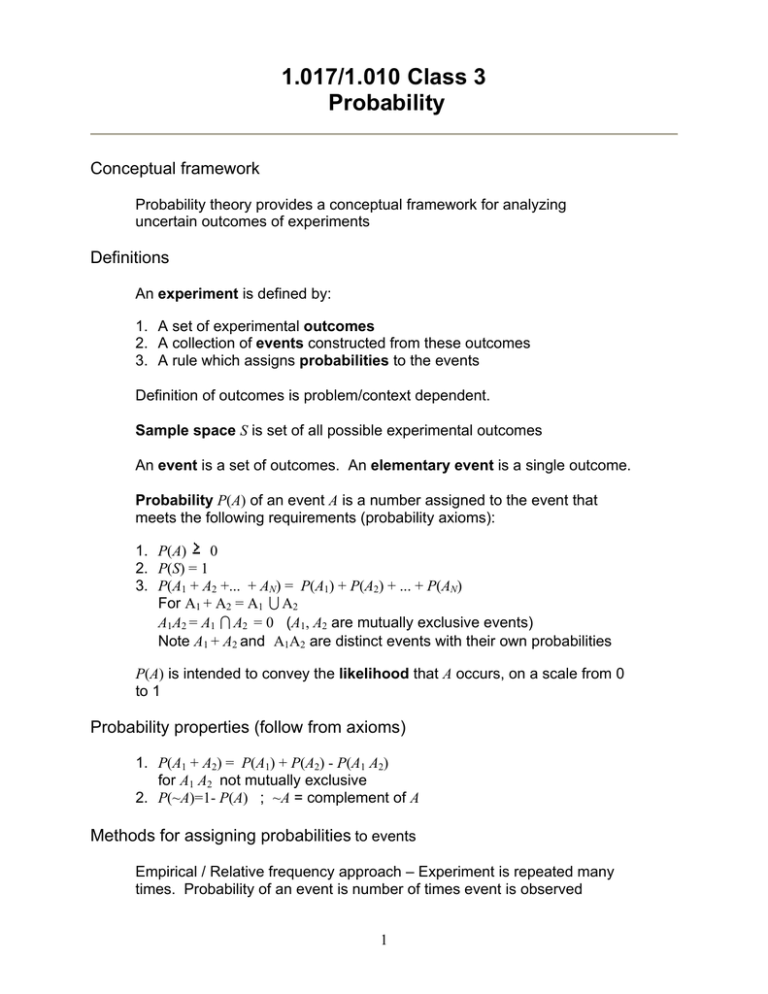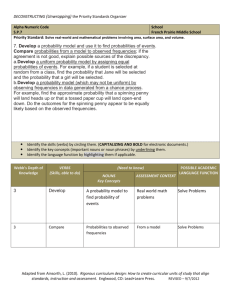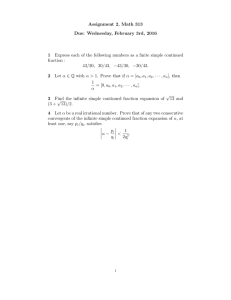1.017/1.010 Class 3 Probability Conceptual framework
advertisement

1.017/1.010 Class 3 Probability Conceptual framework Probability theory provides a conceptual framework for analyzing uncertain outcomes of experiments Definitions An experiment is defined by: 1. A set of experimental outcomes 2. A collection of events constructed from these outcomes 3. A rule which assigns probabilities to the events Definition of outcomes is problem/context dependent. Sample space S is set of all possible experimental outcomes An event is a set of outcomes. An elementary event is a single outcome. Probability P(A) of an event A is a number assigned to the event that meets the following requirements (probability axioms): 0 1. P(A) 2. P(S) = 1 3. P(A1 + A2 +... + AN) = P(A1) + P(A2) + ... + P(AN) For A1 + A2 = A1 U A2 A1A2 = A1 I A2 = 0 (A1, A2 are mutually exclusive events) Note A1 + A2 and A1A2 are distinct events with their own probabilities P(A) is intended to convey the likelihood that A occurs, on a scale from 0 to 1 Probability properties (follow from axioms) 1. P(A1 + A2) = P(A1) + P(A2) - P(A1 A2) for A1 A2 not mutually exclusive 2. P(~A)=1- P(A) ; ~A = complement of A Methods for assigning probabilities to events Empirical / Relative frequency approach – Experiment is repeated many times. Probability of an event is number of times event is observed 1 divided by total number of repetitions. Conceptual / deductive approach – Probability of an event is fraction of total outcomes in sample space associated with this event (total outcomes in sample space may be infinite). Distributional approach – Probability of an event is derived from a specified probability distribution (more on this later) Examples: Experiment: Three successive coin tosses Outcomes/elementary events: Different sequences of heads and tails Sample space: 8 possible outcomes/sequences Typical event: Set of outcomes that yield 2 heads and 1 tail Assigning Probabilities (conceptual): P(A) is fraction of total outcomes in event (3/8). Assigning Probabilities (empirical): Replicate sequence of 3 tosses many times, P(A) is observed fraction of replicates giving 2 heads and a tail (not necessarily 3/8). Experiment: Toss of a dart onto a square region of side 2 Outcomes/elementary events: Different locations where dart can land Sample space: Infinite number of possible locations in square Typical events: Inscribed circle of radius 1 Assigning Probabilities (conceptual): P(A) is fraction of S covered by circle (pi/4). Assigning Probabilities (empirical): Toss dart many times, P(A) is fraction of tosses falling in inscribed circle (not necessarily pi/4). Experiment: Selection of a student from a hypothetical infinite population Outcomes/elementary events: Height of any given student Sample space: Infinite number of all possible heights Typical event: Student height is between 5 and 6 feet Assigning Probabilities (distributional): Assume P(A) is partial area under a specified histogram between 5 and 6 feet. Assigning Probabilities (empirical): P(A) is fraction of large sample of student heights that fall between 5 and 6 feet. Exercise: Virtual experiments Write a script that repeats the first two experiments described above (3 coin tosses and 1 dart toss) 20 times. Examine the results of all simulated 20 experiments, manually count the number of times that the events specified above occur, and use the relative frequency approach to estimate the probability of the following events: 2 For dice toss: Event A = (2 heads and 1 tail) For dart toss: Event A = (dart falls in inscribed circle of radius 1) Compare the two relative frequency results with conceptual probability calculations. Some relevant MATLAB functions: rand, unidrnd, ceil, sum, pi MATLAB function: virtual.m Copyright 2003 Massachusetts Institute of Technology Last modified Oct. 8, 2003 3







